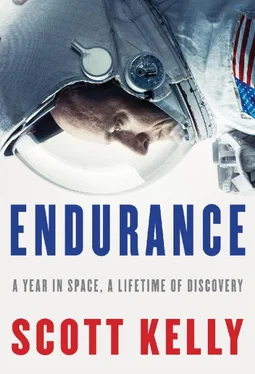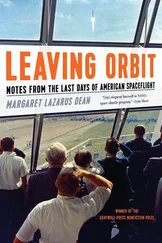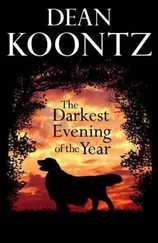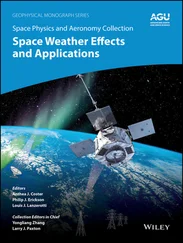The risk taking of my youth is still with me. My childhood memories are of the uncontrollable forces of physics, the dream of climbing higher, the danger of gravity. For an astronaut, those memories are unsettling in one way but comforting in another. Every time I took a risk, I lived to draw breath again. Every time I got myself into trouble, I made it out alive.
Most of the way through my yearlong mission, I was thinking about how much The Right Stuff had meant to me, and I decided to call Tom Wolfe; I thought he might enjoy getting a call from space. Among the other things we talked about, I asked him how he writes his books, how I might start to think about putting my experiences into words.
“Begin at the beginning,” he said, and so I will.
1

February 20, 2015
YOU HAVE TO go to the ends of the Earth in order to leave the Earth. Since the space shuttles were retired in 2011, we’ve depended on the Russians to launch us into space, and we must start with a journey to the Baikonur Cosmodrome on the desert steppes of Kazakhstan. First, I fly from Houston to Moscow, a familiar journey of eleven hours, and from there ride in a van to Star City, Russia, forty-five miles away—anywhere from one to four hours, depending on Moscow traffic. Star City is the Russian equivalent of the Johnson Space Center; it’s the place where the cosmonauts have been trained for the last fifty years (and, more recently, the astronauts who will travel to space with them).
Star City is a town with its own mayor and a church, museums, and apartment blocks. There is a giant statue of Yuri Gagarin, who became the first human in space in 1961, taking a simple, humble socialist-realist step forward while holding a bouquet of flowers behind his back. Years ago, the Russian space agency built a row of town houses especially for us Americans, and staying in them is sort of like staying on a movie set based on a Russian stereotype of how Americans live. There are huge fridges and huge TVs but somehow everything is slightly off. I’ve spent a lot of time in Star City, including serving as NASA’s director of operations there, but it still feels foreign to me, especially in the heart of the frozen Russian winter. After a few weeks of training, I find myself longing to head back to Houston.
From Star City we fly 1,600 miles to Baikonur, once the secret launch site for the Soviet space program. People sometimes say that a place is “in the middle of nowhere,” but I never say that anymore unless I’m talking about Baikonur. The launch site was actually built in a village called Tyuratam, named for a descendant of Genghis Khan, but was referred to as Baikonur, the name of another town several hundred miles away, as subterfuge. Now this is the only place called Baikonur. Early on, the Soviets also referred to their launch facility as Star City so as to further confuse the United States. For an American who grew up and trained as a Navy pilot during the tail end of the Cold War, it will always feel a bit strange that I’m invited into the epicenter of the former Soviet space program to be taught its secrets. The people who live in Baikonur now are mostly Kazakh, descendants of Turkic and Mongol tribes, with a minority of ethnic Russians who were left behind after the breakup of the Soviet Union. Russia leases the facilities here from Kazakhstan. The Russian ruble is the main currency, and all the vehicles have Russian license plates.
From the air, Baikonur seems to have been flung randomly onto the high desert steppes. It’s a strange collection of ugly concrete buildings, horribly hot in summer and harshly cold in winter, with mounds of rusting, disused machinery piled everywhere. Packs of wild dogs and camels scrounge in the shadows of aerospace equipment. It’s a desolate and brutal place, and it’s the only working human spaceport for most of the world.
I’m descending toward Baikonur in a Tupolev 134, an old Russian military transport plane. This aircraft might once have been outfitted with bomb racks and in a pinch could have served as a bomber, part of the Cold War arsenal the Soviets developed with the purpose of attacking my country. But now it’s used to transport international crews of space travelers—Russian, American, European, Japanese, and Canadian. We are former enemies remade as crewmates, on our way to the space station we built together.
The front of the plane is reserved for the prime crew (my two Russian crewmates and me) and a number of VIPs. Occasionally I wander toward the back, where I’ve flown on previous trips to Baikonur. Everyone has been drinking since we left Star City this morning, and the junior Russian personnel have their own party going on back here. Russians never drink without eating, so in addition to vodka and cognac they are serving tomatoes, cheese, sausage, pickled cucumbers, dried salty fish chips, and slices of salted pork fat called salo. On my first trip to Kazakhstan, in 2000, I was making my way through the party at the back of the plane to find the bathroom when I was stopped and forced to drink shots of samogon, Russian moonshine. The junior guys were so drunk they were stumbling around from the turbulence and alcohol, spilling the stuff on themselves and on the floor of the plane, all while chain-smoking. We were lucky to have made it to Kazakhstan without exploding into a giant fireball of moonshine and jet fuel.
Today everyone is drinking heavily again, and we are pretty well fueled by the time we plunge from the clouds over the flat, frozen desert and touch down on Baikonur’s single runway. We climb out, blinking in the cold, and encounter a welcoming party: officials from Roscosmos, the Russian space agency, and Energia, the company that builds the Soyuz spacecraft, one of which will take us into orbit to dock with the International Space Station. The mayor of Baikonur is here, as well as other local dignitaries. My Russian crewmate Gennady Padalka strides forward and speaks sternly to them as we stand at semi-attention, “ My gotovy k sleduyushchim shagam nashey podgotovki. ” (“We are ready for the next steps of our preparation.”)
This is a ritual, like so many in spaceflight. We Americans have similar staged moments at similar points of launch preparation. There is a fine line between ritual and superstition, and in a life-threatening business such as spaceflight, superstition can be comforting even to the nonbeliever.
We see a strange but welcoming sight at the edge of the tarmac: a group of Kazakh kids, little ambassadors from the end of the Earth. They are round cheeked, black haired, mostly Asian in appearance, wearing bright, dusty clothes and holding balloons. The Russian flight doctor has warned us to stay away from them: there has been concern about a measles outbreak in this region, and if one of us were to be infected it would bring serious consequences. We have all been vaccinated, but the Russian flight surgeons are very cautious; no one wants to go to space with measles. Normally we do what the doctor says, especially since he has the power to ground us. But Gennady walks confidently forward anyway.
“We must say hello to the children,” he says firmly in English.
I’ve known both Gennady and our third crewmate, Mikhail Kornienko (“Misha”), since 2000, when I started traveling to Russia to work on the joint space station program between our two countries. Gennady has a thick head of silver hair and a sharp gaze that doesn’t miss much. He is fifty-six and is the commander of our Soyuz. He’s a natural leader, gruffly shouting out orders when necessary but listening carefully when one of his crew has another perspective. He’s a person I trust implicitly. Once, in Moscow, near the Kremlin, I saw him break away from his fellow cosmonauts to pay his respects at the site where an opposition politician had been murdered, possibly by surrogates of Vladimir Putin. For a cosmonaut, an employee of Putin’s government, that gesture was risky. The other Russians with us seemed to be reluctant even to discuss the murder, but not Gennady.
Читать дальше













